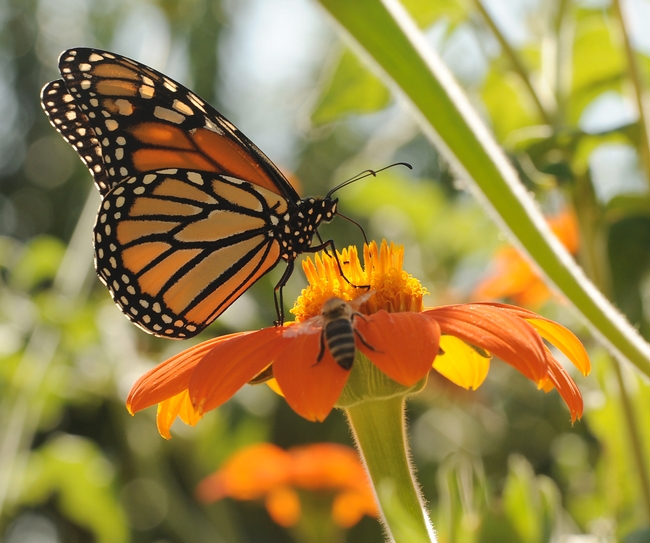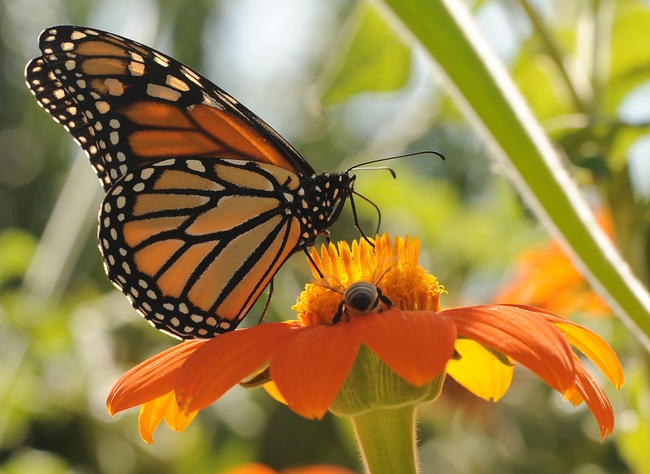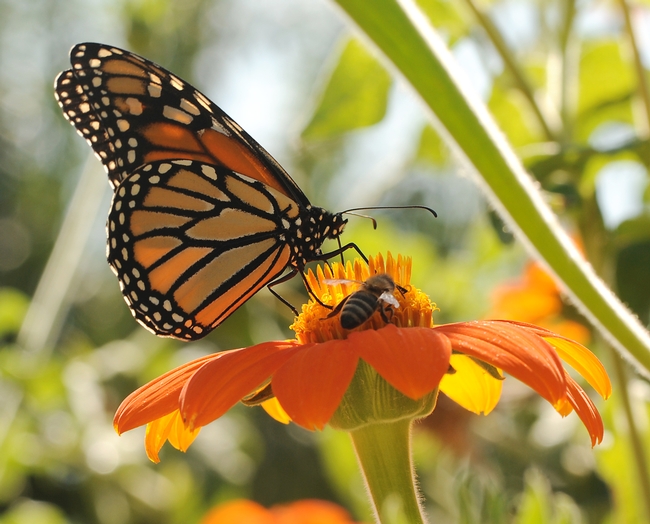- Author: Kathy Keatley Garvey
If you have Mexican sunflowers (genus Tithonia) in your garden, you can expect a diversity of insects--and not just honey bees.
Lately we've been photographing all the insects that visit the Tithonia in our bee garden.
They include butterflies (including monarchs, Gulf Fritillaries, skippers and cabbage whites) bumble bees (Bombus vosnesenskii and Bombus fervides, formerly known as Bombus californicus), sweat bees, leafcutter bees, long-horned bees, praying mantids, honey bees, carpenter bees, and yes, flies (green bottle fly).
The Mexican sunflower, an annual in the sunflower family, Asteraceae, originates from Mexico and Central America. What's good about the Tithonia--besides its sizzling color and its ability to attract a diversity of insects--is that it's drought-tolerant. That's especially important as we thirsty Californians endure our worst-ever drought.
We grew our Mexican sunflower (Tithonia rotundifolia) from seed, and it should bloom all summer. Already it's reaching NBA basketball-stature--topping seven feet in height.
We may have to set up a orchard ladder in our bee garden on our next photo shoot!





- Author: Kathy Keatley Garvey
It's good to see so many scientists and citizen scientists taking an avid interest in monarchs.
The monarch butterfly (Danaus plexippus), probably the most recognizable of all the butterflies, is known for its long migratory route from Canada to Mexico.
We spotted a beautiful monarch last Sunday afternoon in Fair Oaks, Calif. as it foraged for nectar from an appropriately named "butterfly bush" (Buddleia davidii).
We watched the monarch glide, drop down, and nectar on the blossoms--a beautiful sight to see. The larval host plant is the milkweed, also a beautiful sight to see--especially when the caterpillars "decorate" the leaves. From an egg to a caterpillar to a chrysalid to an adult, the life cycle should be one of the seven wonders of the world.
Meanwhile, there's a major monarch event taking place Friday, June 6 at the Chicago Botanic Gardens. It's an all-day symposium about monarchs and their conservation, "Make Way for Monarchs: Alliance for Milkweed and Butterfly Recovery." Speakers include Lincoln Brower, Karen Oberhauser, Chip Taylor, Gary Nabhan, and Scott Hoffman Black. An organization called makewayformonarchs.org conducts "research on monarch butterfly recovery and promote positive, science-based actions to avert food web collapse in the milkweed community and the further demise of the monarch migration to Mexico," according to the Chicago Botanic Garden website promoting the Friday event. "They aim to promote social engagement to implement tangible solutions in midwestern landscapes through collaborative conservation."
There's also a MonarchWatch organization dedicated to restoring the Monarch butterfly populations.
More closer to home, Oakland parks supervisor Tora Rocha of the Pollinator Posse is spearheading a drive to rear monarchs. She posts many photos of the caterpillars and adults on the Pollinator Posse Facebook page. Check out the YouTube video featuring her, the monarchs and the Pollinator Posse.
"It's addicting," she says.
Want to help? Listen to the YouTube video and accept her invitation "to come join us."



- Author: Kathy Keatley Garvey
It happened so quickly.
The monarch butterfly (Danaus plexippus) fluttered to the lantana for a sip of nectar when the unexpected happened.
A praying mantis, lying in wait, leaped high and grabbed it by its wings.
Unable to fly, the monarch struggled to right itself. The praying mantis kept its viselike grip.
Caught.
At the time, I was focusing on the butterfly and didn't see the predator. When I saw the butterfly struggling, I walked over to it and lifted it out of the lantana, only to find a praying mantis attached to it.
The butterfly did not make it. The praying mantis, a female about to lay eggs, did. She will be shown at the Bohart Museum of Entomology's open house on Saturday, Sept. 21 from 1 to 4 p.m. and then released.
Theme of the Bohart open house is "Live at the Bohart!" Live? That's because the open house will feature live insects, such as cabbage white and Gulf Fritillary butterflies, Madagascar hissing cockroaches, walking sticks, a rose-haired tarantula and a “Harry Potter bug,” which is an amblypygid commonly known as a whip spider or tailless whip scorpion.
The Bohart, located on the UC Davis campus in Room 1124 of Academic Surge on Crocker Lane, formerly California Drive, is home to nearly eight million insect specimens, collected throughout the world.
At the open house, museum officials will tell you how to rear a cabbage white butterfly and other butterflies, such as Gulf Fritllaries. You can talk insects with director Lynn Kimsey; senior museum scientist Steve Heydon; public education/outreach coordinator Tabatha Yang, and others. The gift shop will be open for the purchase of t-shirts, jewelry, posters, books, insect nets and other items.
As for the praying mantis, on Saturday she will be freed to catch more prey.
Let's hope it is a cabbage white instead of a monarch.




- Author: Kathy Keatley Garvey
It's not often you see a monarch butterfly and a digger bee in the same photo.
Such was the case on a recent visit to a lantana patch at a west Vacaville home.
The monarch butterfly touched down on a blossom and was beginning to nectar when along comes a digger bee, a male Anthophora urbana (as identified by native pollinator specialist Robbin Thorp, emeritus professor of entomology at the Universit of California, Davis.)
"Maybe it was planing on dive bombing the big intruder from his territory," Thorp said. "However, these males are not known to be especially territorial. Maybe he's just checking out the competition for nectar."
This is the solitary, ground-nesting bee that Leslie Saul-Gershenz, graduate student in the Neal Williams lab at UC Davis, is researching. She's published research on a species of digger bee, Habropoda pallida, a solitary ground-nesting bee, and its nest parasite, a blister beetle, Meloe franciscanus, found in the Mojave Desert ecosystem.
Now she's also including Anthophora.
“Our preliminary data show that the blister beetle exploits four other native California bees including important pollinators in the genus Habropoda and Anthophora," she recently told us.
Historically, the blister beetle, Meloe franciscanus, was known to be a nest parasite of Anthophora edwardsii, distributed throughout California.
See her amazing photo of the parasitic larvae of the blister beetle on the digger bee, Habropoda pallida, on the UC Davis Entomology website.

- Author: Kathy Keatley Garvey
The mighty Monarch butterfly and the industrious honey bee.
How rare we see them together on the same flower.
But that was the case last Friday at the Häagen-Dazs Honey Bee Haven, a half-acre bee friendly garden planted next to the Harry H. Laidlaw Jr. Honey Bee Research Facility at the University of California, Davis.
The butterfly touched down on a brilliant orange Mexican sunflower (Tithonia) and began nectaring. A honey bee crawled up the petals. So there they were, sharing nectar. They saw one another. They acknowledged one another. And they ignored one another.
Finally, the bee buzzed off to forage on her very own Mexican sunflower.
It was a butterfly-bee moment. Or more technically, a Danaus plexippus/Apis mellifera moment.
Two may be company, but sometimes it's best to get your own flower.





